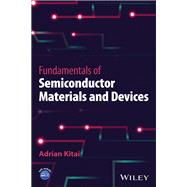Gain an introduction to the concepts behind semiconductor materials and devices in this advanced textbook
Semiconductors are the foundation of the electronics industry, and therefore to virtually all modern technology. No engineer or materials scientist can be without an understanding of these essential technologies. Since they are also the foundation of solar cells, they play an increasingly critical role in the transition to sustainable technology and promise, as a result, to become even more central in global technological progress.
Fundamentals of Semiconductor Materials and Devices is a textbook that presents the advanced principled underlying semiconductors in an accessible and comprehensive way. Combining material from both engineering and physics, it remains grounded throughout in practical applications of semiconductors. Its approach makes it ideal for readers looking to gain a thorough understanding of this ubiquitous technology.
Fundamentals of Semiconductor Materials and Devices readers will also find:
- Questions and exercises to stimulate learning and increase comprehension
- Introductory chapters detailing the fundamentals of quantum and solid state physics, as well as the foundational principles of semiconductor tech
- Detailed analysis of topics including flash memory, the quantum dot, two-dimensional semiconductor materials, and more
Fundamentals of Semiconductor Materials and Devices is a valuable guide for students and researchers in any area of engineering, physics, or materials science.









